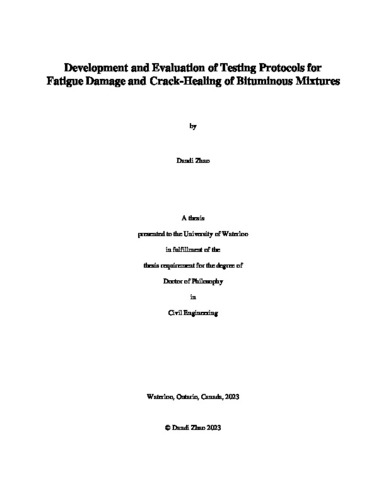| dc.contributor.author | Zhao, Dandi | |
| dc.date.accessioned | 2023-04-26 12:55:58 (GMT) | |
| dc.date.available | 2024-04-26 04:50:04 (GMT) | |
| dc.date.issued | 2023-04-26 | |
| dc.date.submitted | 2023-04-25 | |
| dc.identifier.uri | http://hdl.handle.net/10012/19328 | |
| dc.description.abstract | Fatigue testing is a very important performance test for asphalt concrete mixtures and has been studied for many years with varying levels of success. However, there are several imperfections in the commonly used fatigue tests. Furthermore, there is currently no universal standard to define fatigue failure in these tests, as fatigue damage cannot be effectively quantified due to the presence of bias effects. Researchers have used modified fatigue tests to study the self-healing capability of bituminous material. The healing capability of the material is typically quantified by comparing the modulus change with and without rest periods. However, the presence of reversible phenomena makes it even harder to quantify the healing effects. This research aims to improve the laboratory asphalt concrete fatigue damage and crack-healing tests by combining Non-destructive testing (NDT) methods.
This study was conducted on polymer-modified asphalt concretes. The properties of the material used has been well studied in previous research and were used to compare with the results from this research. An ultrasonic pulse propagation test (UPPT) was conducted on undamaged specimens, specimens under monotonic loading and cyclic loading conditions, and during the healing processes. Two experimental protocols that combine traditional asphalt fatigue or cracking tests with UPPT to quantify and evaluate the damage and self-healing property of asphalt concrete were proposed. Several signal processing techniques were applied to study the performance of the test material.
The results indicate that the UPPT method is sensitive to the microstructure, viscosity, elasticity, damage level and healing properties of asphalt concrete. The proposed Dynamic High-frequency Healing with Rest Period (D2HRP) test protocol successfully distinguishes changes in healing between stiffer and more aged binders. The combination of ultrasonic pulse propagation tests and tension-compression tests provides an indirect observation of changes of material property during the test, and the proportion of the bias effects were successfully quantified. The improved laboratory cracking and fatigue tests can promote sustainability in pavement materials and designs. Furthermore, this project will also contribute to a better understanding of crack initiation and propagation processes in pavement materials, which can improve the existing state of pavement rehabilitation and maintenance techniques as well as pavement condition prediction models. | en |
| dc.language.iso | en | en |
| dc.publisher | University of Waterloo | en |
| dc.title | Development and Evaluation of Testing Protocols for Fatigue Damage and Crack-Healing of Bituminous Mixtures | en |
| dc.type | Doctoral Thesis | en |
| dc.pending | false | |
| uws-etd.degree.department | Civil and Environmental Engineering | en |
| uws-etd.degree.discipline | Civil Engineering | en |
| uws-etd.degree.grantor | University of Waterloo | en |
| uws-etd.degree | Doctor of Philosophy | en |
| uws-etd.embargo.terms | 1 year | en |
| uws.contributor.advisor | Baaj, Hassan | |
| uws.contributor.advisor | Tavassoti, Pejoohan | |
| uws.contributor.affiliation1 | Faculty of Engineering | en |
| uws.published.city | Waterloo | en |
| uws.published.country | Canada | en |
| uws.published.province | Ontario | en |
| uws.typeOfResource | Text | en |
| uws.peerReviewStatus | Unreviewed | en |
| uws.scholarLevel | Graduate | en |

